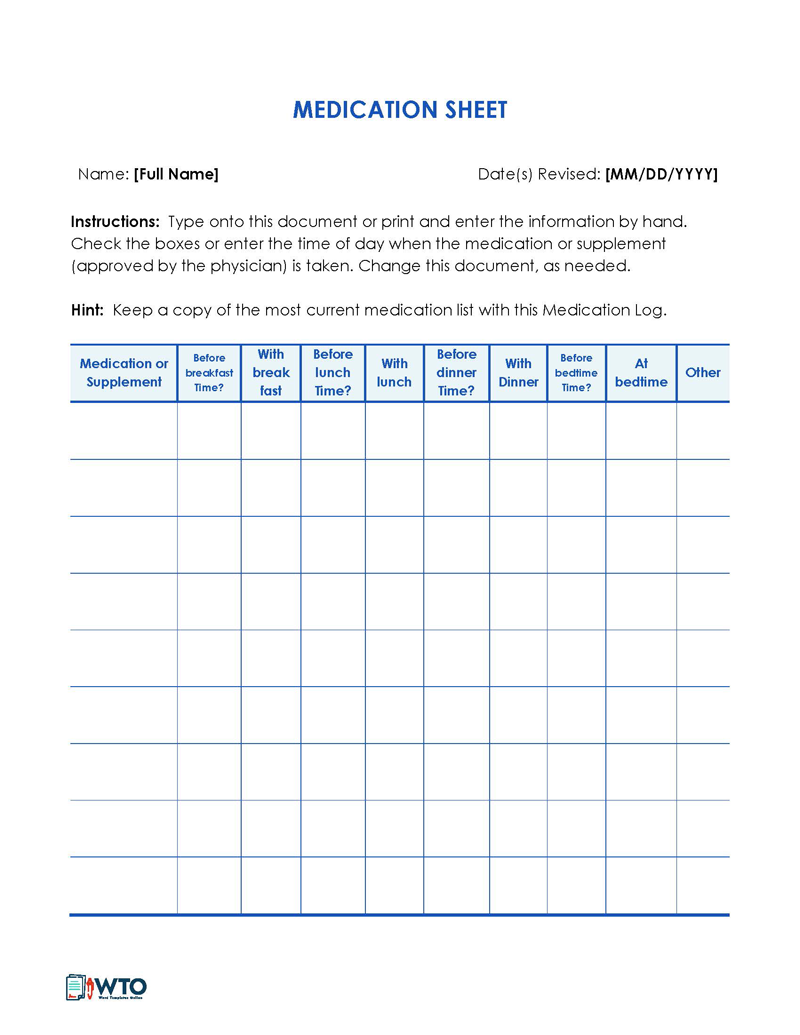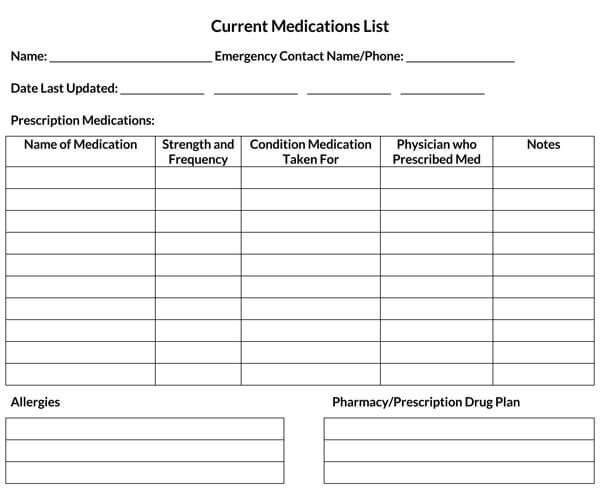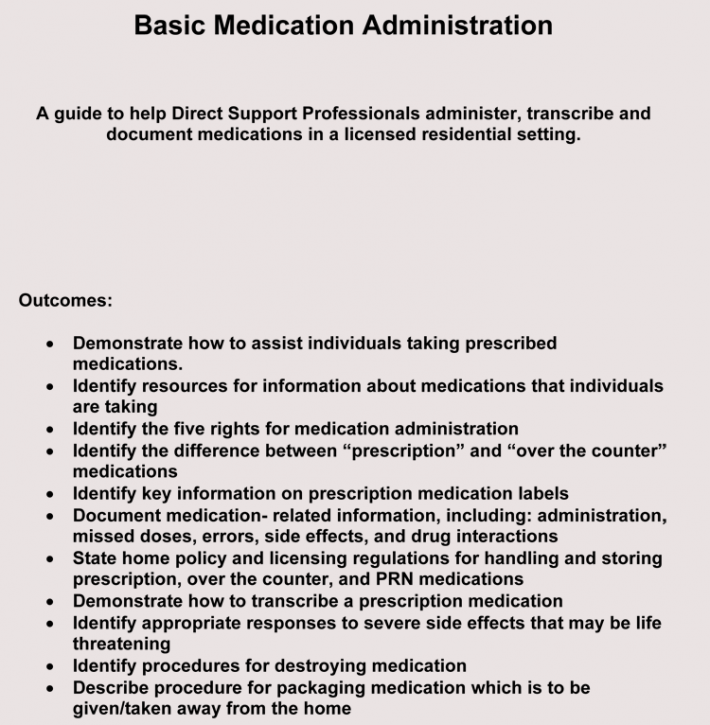A medication list template is a preformatted document that contains a comprehensive list of the drugs that a patient is taking.
It is a valuable tool that helps patients keep track of the medications they are taking, as it allows them to easily and accurately monitor their medication regimen.
It is also referred to as a:
- Medication diary
- Medication log sheet
- Medication record
- Medication chart
The drugs may be prescribed, over-the-counter, or regular supplements. Apart from the name of the medication, the template also includes fields for other information, such as dosage, mode of administration, date and time of administration, the prescribing health provider, and ATIs (Allergies, Tolerances, and Intolerances). The template can be printed, electronic, or cloud-based, and its use can help minimize dosage errors.
Therefore, it is crucial for you to learn how to draft, maintain and use a medication sheet. With a little time and creativity, you may easily make your own template. However, if you wish to save time, you can access free templates from this website or ask your healthcare provider to assist you with one. They are easy to navigate and will help you manage drug administration efficiently.
This article will discuss the elements of the template and its significance. Some best practices to consider have also been addressed, along with some free downloadable templates for your convenience.
Advantages of Using a Template for a Medication List
It is important to take prescribed medication at the right time of day. Proper drug management ensures medications are effective in treating diseases and injuries.
Discussed below are some of the benefits of using a template for the list:
Saves time and effort
With a pre-made format for imputing medical information, a template will save you time and effort as you do not have to create one from scratch whenever your doctor requires your medical information. This is beneficial, especially if you are on multiple drugs or have a complex medication regimen.
Provides a standardized format for organizing information
A template presents a standardized format for presenting medications administered, leading to increased efficiency. All drug information is accessible and readily available from a centralized location. Whenever you have prescribed a new drug, you can easily add it to the template. It allows doctors to review your history, even if they have never interacted with you.
Reduces the risk of errors or omissions
Using a template minimizes the risk of errors and omissions, thus providing higher accuracy in patient care. You can keep track of the specific medicine and doses administered. This can help reduce the likelihood of medication errors, for example missing a dose or overdosing, which can be detrimental. With increased accuracy, your medication will more likely target the intended health issue and relieve pain much faster.
Helps you remember important details about your medications
With a template, it is impossible to miss pertinent details about your medication, such as the name of the drug, dosage, reason for taking the medication, and frequency of administration. By including all the details about your medications, your doctor may assess your history and use the information to make informed medical decisions. As a result, higher clinical outcomes are achieved, which can contribute to your overall improved health.
Free Templates
Given below are downloadable templates:






Components of a Medication List Template
Missing even a single dose of medication can adversely affect your health. Therefore, using a template for a medication sheet is recommended to ensure you have taken all your prescribed drugs.
If you are unsure how to make an organized list, below are the essential components you should include:
Personal information
The first component of the template is your personal information. This should include dedicated spaces for your name, date of birth, age, gender, phone number, and physical address. You can also include spaces for your medical insurance information. These details associate the list with you and provide crucial information to your healthcare provider, especially during an emergency.
Medication information
Next, include a section in the template to list all the medications you have been prescribed, dosage, and frequency of administration. This includes over-the-counter drugs, herbal and natural medicines, prescribed and non-prescribed medication, blood derivatives, vaccines, radioactive medicine, diagnostic and contrast agents, and intravenous solutions.
Also, include a space in this section to specify the drugs’ purpose and manner of administration, whether oral or by injection. A section specifying when the medication is taken should also be included. All this information provides accurate details about your medication regimen to your healthcare provider.
ATI
ATI refers to allergies, tolerances, and intolerances. It is critical to share this information with your healthcare provider to ensure the safest and most effective medication therapy. Allergies are an immune system response to otherwise harmless substances.
Tolerances and intolerances refer to the body’s ability or inability to handle and adapt to substances without experiencing adverse effects. In the template, include a section to list your ATIs so your healthcare provider can identify which drugs are safe and unsafe to administer so that they can adjust your medication regimen accordingly.
Supplements and vitamins
Include a section on the template to record any nutritional and mineral supplements or vitamins taken together with prescribed medication. These are not normally prescribed, as they may interact with other medications and cause adverse effects. It is imperative to let your healthcare provider know about additional supplements so they can adjust your medication regimen.
Prescriber information
Your template should have a section to include the prescriber’s information. Include spaces for specifying the physician’s full name, department, hospital name, and prescription date. Should you change healthcare provider in the future, having this information allows your new provider to contact the previous one for any medical information. You can also contact your physician should you have any concerns or questions about your regimen.
Pharmacy information
This section of the template is used to specify the name and contact information of the pharmacy where your prescription was filled. These details are useful in the event of an emergency or when you make your next visit to the hospital, as they help keep track of where the medication was obtained.
Date and signature
Finally, include a section in the template for your handwritten signature and the date of drug administration. This helps authenticate the information in the chart and encourages regular updating. You may also include a placeholder for the prescriber’s signature to clarify that they are the ones who prescribed the specific medicines.
Remembering to include all of the details listed above may seem impossible. To assist you, we have provided a number of free downloadable templates for medication sheets. They have placeholders for all the necessary information and are easy to customize, making it possible to modify them to your preferences. Moreover, they encourage safe medication practices since you no longer have to worry about missing doses.
Medical List Forms




















Best Practices for Using a Medication List
A medication chart is critical to your treatment since it provides valuable information to your healthcare provider. To make it as efficient as possible, consider the following best practices:
Keep the list up-to-date
You should regularly review and update your medication form. Update the list when a change occurs, such as a new prescription, a dose change, or if a dose is stopped. This allows you to protect your health and not skip any medication dosage.
Use a standardized template
The list is more than just a piece of paper since it helps manage your prescriptions and hasten your recovery. Use a standardized template to capture important information about your current treatment regimen before an appointment. It allows you to share critical medical information with your healthcare provider since they can retrieve it whenever needed.
Review the list with healthcare providers
It is advisable to share your list with all of your healthcare providers, especially if there have been modifications since your last visit. They can review the list and note the impacts of the medication in order to adjust your dosage. Your healthcare providers might not share health records among themselves, but you should bring your list to your healthcare appointments to discuss any changes or updates that are necessary.
Keep a copy of the template
Keep a hard copy of the template to update your medication regularly, especially if you move around a lot. It is best to have it in your wallet, handbag, briefcase, or an accessible location like your car. This way, you can easily locate it during a health emergency if you are unable to communicate. You can also leave a copy of the list with a family member, a relative, or a close friend. This might come in handy if your list gets lost or damaged.
Track medication administration
Use a template to keep track of your medication by recording the name of the drugs, dosage, date and time of administration, and frequency of use. This helps ensure you are taking your drugs as prescribed. It also makes healthcare providers aware of the medication you are taking in case of a medical emergency.
Bottom Line
A medication log allows you to track medication intake and aids in scheduling prescriptions, including over-the-counter and prescription drugs, vitamins, and dietary supplements. The list contains all medications taken regularly or occasionally, as well as the dosage, frequency of intake, ATIs, and other pertinent information. Most healthcare providers require patients to bring a comprehensive medication list to all appointments. This information is used to evaluate your progress or to modify treatment.
Failure to take prescribed medication at the appropriate time can be fatal. You can use a template to help you keep track of the dosage, side effects, and instructions provided by the prescribing physician. Our free downloadable templates also allow you to record the contact information of the prescribing physician in order to address any errors that may occur. Ultimately, the objective is to limit the likelihood of medication errors by monitoring when and how drugs should be administered.












